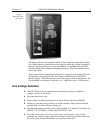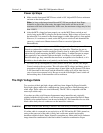
Version 1.A Model IIC-200 Operation Manual 7
Note:
The Model IIC-200 has automatic circuitry to help prevent damage. However, it
is far better not to place an expensive intensifier at risk than to depend on the protection
circuitry.
Features
Independently variable MCP power supply, independent of phosphor voltage.
Automatic alarm and shutdown in case of excessive phosphor current.
Automatic brightness control switch for ease of focus.
Gate input for gating between 5 nsec and DC, electronic shuttering input for long
gate times or CW operation.
Compatibility with Princeton Instruments gate pulsers and controllers.
Specifications
MCP power supply:
500 to 1000 volts, 100 µA maximum. Contact the factory for
higher current applications up to 500 µA.
Intensifier bias levels (Standard Configuration):
Phosphor:
0 volts, i.e. grounded phosphor.
MCP-Out:
-5500 volts typical, Gen II
MCP-In:
-6000 to -6500 volts typical, Gen II
Photocathode to MCP-In voltage:
-180 volts in CW mode, +40 volts in gate
mode, Gen II. Gen IV versions have voltages appropriate to Gen IV intensifiers.
Gate pulse
Gen II Intensifier:
-180 to -220 V, 5 nsec to 1 msec, externally supplied.
Princeton Instruments PG-200 Pulser recommended.
Gen IV Intensifier:
Approximately -1000 V, 12 nsec to 1 msec, externally
supplied. BNC Corp. Model 6040 Pulse Generator with Model 310H plug-in
module recommended (12 ns to 10 µs).
Shutter pulse:
5 volt TTL input. Logic 1 turns the Intensifier on in CW mode.
Logic 0 (0 V) turns it off. Used to achieve gate times longer than the 80 ms delay +
gate width obtainable with a PG-200. Minimum TTL 1 pulse width to turn intensifier
on is 50 sec.
Automatic Brightness Control:
Gain reduction of 16 typical under maximum
incident light.
Phosphor over-current shutdown:
30 nA typical. Over-current condition
sounds audio beeper.
Audio beeper:
~1 kHz, cycles on/off at rate dependent on overload.


















